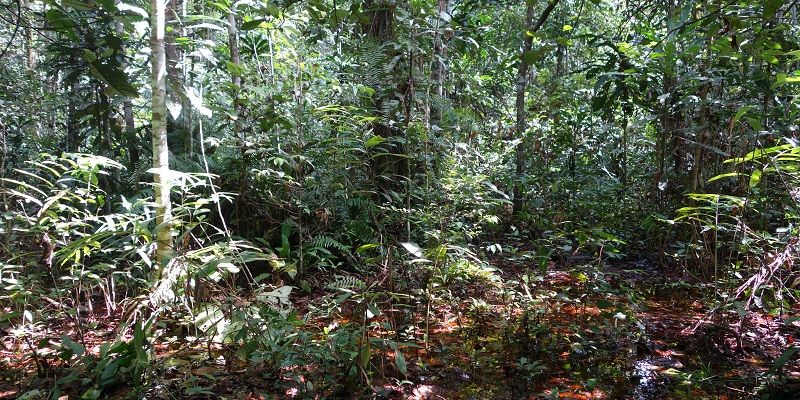
The world’s forests have absorbed more than 100 billion tonnes of carbon dioxide over the past three decades, but they need more protection, according to a new study.
Professors Oliver Phillips and Simon Lewis from the School of Geography contributed to the tropical component of the global study, which assessed how the most carbon-rich, species-rich forests have responded to climate change and other threats since 1990.
The study, entitled “The enduring world forest carbon sink,” is published in Nature.
It combined long-term ground measurements with remote sensing data to measure the volume of carbon dioxide absorbed by forests across the world.
The results showed that forests have absorbed more than 100 billion tonnes of carbon dioxide over the past 30 years, nearly half of the carbon dioxide emissions from burning fossil fuels over the same period.
Forests remain an essential part of climate change mitigation. However, they are facing threats from deforestation and wildfires. This study makes recommendations for their protection and restoration.
Keep forests standing and healthy and they provide huge climate benefits.
Professor Oliver Phillips leads RAINFOR: The Amazon Forest Inventory Network, an international collaboration to understand Amazon ecosystems, and the global ForestPlots.net alliance which monitors forests in over 50 countries.
He said: “The extraordinary persistence of the carbon sink shows the great resilience of nature to climate change so far.
“Right now, deforestation, fire and logging are damaging forests everywhere, but drought less so. Helping Earth’s forests resist climate change means keeping them as intact, healthy and vibrant ecosystems.”
Professor Simon Lewis, who leads the African Tropical Rainforest Observation Network, commented: “Undisturbed African tropical forests, including the vast forests of the Congo Basin, are making a remarkable contribution to slowing climate change by absorbing carbon from the atmosphere.
“The message from the tropics is clear: keep forests standing and healthy and they provide huge climate benefits.
“What is needed are formal collective land rights for local people who have a long-term stake in the survival of their forests, and financial mechanisms to make forests worth more alive than dead.”
Professor Phillips added: “We know what has happened thanks to partners measuring inside forests for decades. It bears reflection that careful, on-the-ground work by dedicated tropical scientists is absolutely essential. Without them we wouldn’t understand how forests are faring.”
The research was co-led by USDA Forest Service Northern Research Station Senior Research Scientist Yude Pan and Senior Scientist Richard Birdsey from Woodwell Climate Research Center, alongside 15 co-authors from 11 countries.
Dr Pan explained: “Our research team analysed data from millions of forest plots around the globe. What sets this study apart is its foundation in extensive ground measurements – essentially, a tree-by-tree assessment of size, species, and biomass.
“While the study also incorporates remote sensing data, a common tool in national forest inventories and land surveys, our unique strength lies in the detailed on-the-ground data collection.”
Forests in different areas have different outcomes
The research investigated forests across the world including boreal forests in Northern Hemisphere areas across Alaska, Canada and Russia, tropical forests such as the Amazon Rainforest and the Congo Basin Forest, and temperate forests in between. They found that the carbon sink capacity of boreal and tropical forests has significantly decreased.
Boreal forests have experienced a 36% drop in capacity due to disturbances like wildfires, insect outbreaks and soil warming. Deforestation has caused a 31% decline in tropical forests’ ability to absorb carbon. However, regrowth in agricultural and logged areas has partially offset these losses.
In contrast, the carbon sink capacity of temperate forests has increased by 30%. This is largely due to extensive reforestation efforts, particularly in China. Their recovery shows how land management policies and practices can help to preserve this global carbon sink.
Calls for research and protection of forests
The study makes recommendations to support forests across the world. It calls for an end to deforestation and for more restoration. It suggests improvements to timber harvesting practices to minimise emissions and disruptions to forests.
The study acknowledges the need for increased research in the tropical regions where there are fewer ground sampling plots.
Further information
With ForestPlots.net, Professor Phillips is a partner on the £13m funded GEO-TREES initiative, which focuses on supporting practitioners in the Global South to map and measure forest carbon stocks. ForestPlots.net champions open-access data on forests and carbon stocks to encourage policymakers, researchers and practitioners to understand the trajectory of the land and its effects on the climate.
Professor Lewis has called for more investment into people and resource for research in the Congo Basin Forest, the world’s second largest tropical forest. Despite its size and importance, it is much less understood than the Amazon Rainforest and Southeast Asian rainforests. With African colleagues, he launched the Congo Basin Science Initiative last year to help change this.
All forests are critical in mitigating climate change and supporting biodiversity. Protecting and restoring these ecosystems is essential.
Top image: Congo forest. Image credit: Simon Lewis.
For additional information contact the University of Leeds press office via pressoffice@leeds.ac.uk.
DOI: https://doi.org/10.1038/s41586-024-07602-x